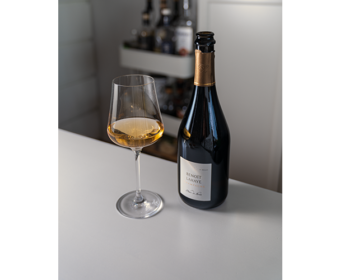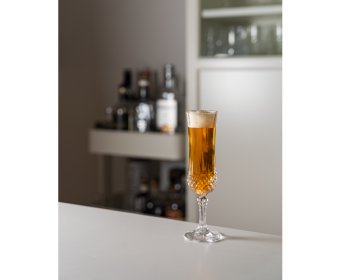The Ultimate Champagne Glass Guide
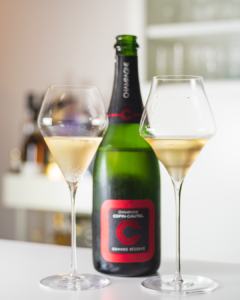
In line with my Ultimate Guide to Eau de Vie Glasses, I again went a bit crazy. I was asking myself which would be the perfect glass for enjoying Champagne? Well, after trying a champagne and a sparkling wine from six different glasses, I can give you the straight answer: It depends!

When I presented the great Copin-Cautel Champagne to you a little while ago, I already mentioned that I tried the wine from different glasses. However, I never would have guessed that the glass made that big a difference. Of course, you can enjoy the champagne from every high-quality glass. However, the wine tasted very different from the individual ones. Since, we also opened a great bottled of German sparkling wine recently, we tried it from the different glasses, too.
Josephinenhütte No. 4 Champagne
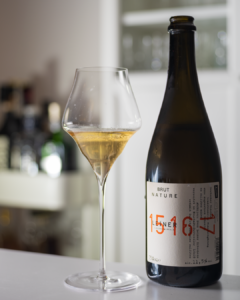
Similar to Torben‘s article at Trinklaune, I noticed that the Josephinen glass emphasizes the acidity and fresher notes in a sparkling wine, too. On top of that, the Perlage is also more pronounced. However, the effect was more noticeable with the champagne than with the Leiner 15 16 17. The Copin-Cautel tasted very citrus forward and quite more sparkling. Apart from that, the No. 4 glass was one of my favourites for the sparkling wine. Conclusion: Exceptional quality glass, perfect glass if you want a kick of freshness in your sparkling wines.
Zalto Sweet Wine

As mentioned in the article on the eau de vie glasses, I already could imagine the Zalto Sweet Wine glass working well with sparkling wine. Well, the short answer is, it did! With both sparkling wines the drinking experience was the most “conventional”. Obviously, this does not translate to “boring”, instead both wines were very balanced with a fair amount of the whole flavour spectrum they could deliver. The yeast and red fruit notes of the Grande Reservé came to the front of the palate without covering up the fresher notes. In contrast, with the Leiner sparkling wine you could taste a distinct honey note. Conclusion: Great all-round champagne glass for medium bodied sparkling wines.
Gabriel Universal Glass
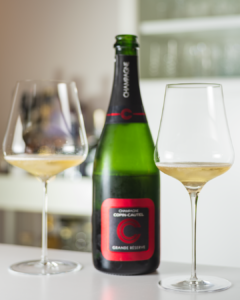
This revolutionary glass wants to be the only glass you use for every style of wine. While a lot of glass manufactures have universal glasses in their portfolio, but most of them offer grape variety specific glasses, too. In our tasting, the Gabriel glass offered a balanced flavour profile with a lot of yellow fruits and more yeast notes than the Josephinen. This was also the case with the Leiner sparkling wine. Conclusion: Exceptionally well-balanced all-round wine glass, in our opinion especially suited for rosés and blanc de noir sparkling wines.
Zalto Bordeaux
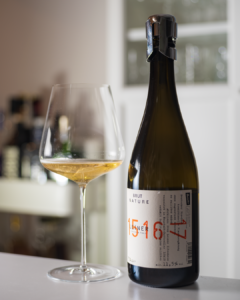
To be honest, I never would have thought about trying a sparkling wine from this red wine glass. However, Michael Hinterleitner from Zalto Glas suggested trying it in the comparison. While with both sparkling wines tested here the glass was a bit too big, I can see that with older sparkling wines and especially champagne this glass has its advantages. With the Copin-Cautel it underlined the yeast notes and suppressed the Perlage the most. Again, things were similar with the Leiner 15 16 17 which also needs a little less space in the glass. However, I will definitely revisit this glass with other, older sparkling wines. Conclusion: Beautiful glass and perfect for sparkling wines which spent a lot of time on the yeast.
Zalto White Wine
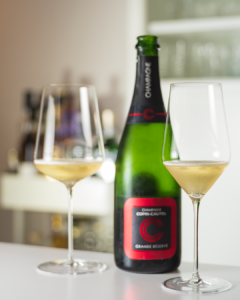
This white wine glass has the typical Zalto shape, but is smaller than the universal glass. It worked very well with the champagne emphasizing the fruity characteristics of the wine. Yet, it even was my favourite with the Leiner. From the white wine glass the sparkling wine was perfectly balanced showing its full flavour potential. Conclusion: A great white wine and sparkling wine glass, in our opinion especially suited for white grape varieties or blanc de blancs.
Zalto Universal Glass

The Zalto Universal Glass is similar to the Gabriel glass, but with a more rectangular shape. There really was not much difference between the two universal glasses. In my opinion the Gabriel worked better with the champagne and the Zalto better with the sparkling wine. Conclusion: A perfect glass for trying a lot of different wines from which slightly tends towards white grapes.
Overall conclusion
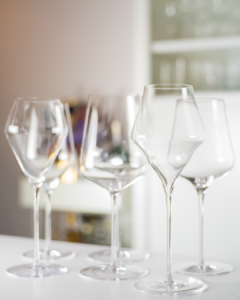
As always there is no such thing as the “perfect” champagne glass. It clearly depends on the style of wine and most of all on personal preferences. Yes, the universal glasses work very well with a lot of different sparkling wines, but there always is the chance of another glass working even better with a certain wine. One thing however that can be said is that the more time a sparkling wine spends on the yeast, the bigger the glass should be to give it more space.
Whisky-honey notes

Last but not least, here are my tasting notes on the Leiner 15 16 17 Brut Nature. The soil that produces the sparkling wine is composed of hillside loam interspersed with land snail limestone. The vines yield 40 hl/ha pinot noir grapes and 75 hl/ha chardonnay. After the early harvest, the spontaneous first fermentation and the malolactic fermentation take place in Tonneaux made from French and Austrian oak. The wine spends between one and two years on the yeast without sulphur. Next, the base wines of the 2015, 2016 and 2017 vintages are blended one third each. On top of that, the 2017 vintage is the sugar source and the starter for the second fermentation. In the end, the wine is bottled without Dosage as a Brut Nature.
*The fact that I received a product reviewed in this article for free, did not – in any way – influence the rating of said product. The glasses were provided by Gabriel Glas, Josephinenhütte and Zalto. The champagne was provided by ChampangerDirekt.de


